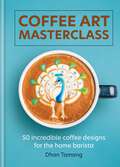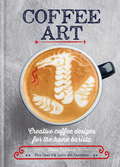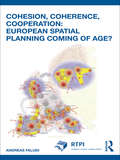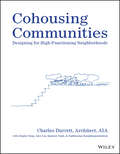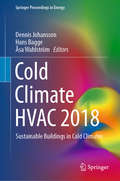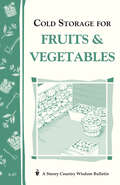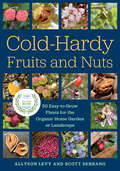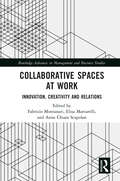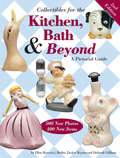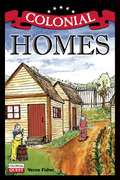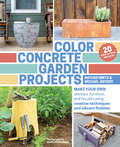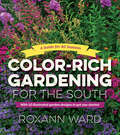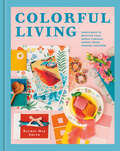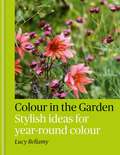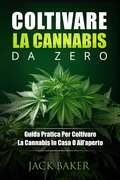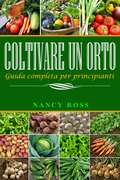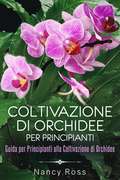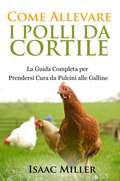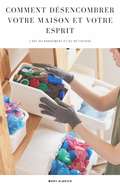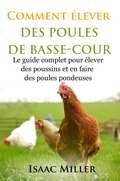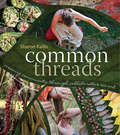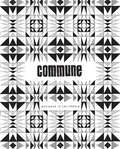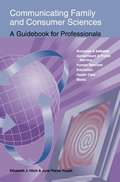- Table View
- List View
Coffee Art Masterclass: 50 incredible coffee designs for the home barista
by Dhan TamangTake your coffee art to the next level with 50 spectacular-yet-simple latte art designs to impress family and friends. From the comfort of your own kitchen you can recreate great paintings, pour and etch stunning natural wonders, iconic buildings and fantastical creatures. No special equipment is needed and once you've mastered the basics a world of incredible coffee art awaits you.Coffee Art Masterclass includes next-level latte designs that everyone can achieve.
Coffee Art: Creative Coffee Designs for the Home Barista
by Dhan TamangOver 128 pages of 60 stunning designs from Britain's champion latte artist. From free pouring to etching, stencilling and more complicated designs for the black belt barista, you'll have fun emulating innovative designs such as The Swan, The Unicorn, and frothy 3-D babyccino animals. The book even includes 9 stencil patterns for you to trace and try.Starting with basic skills and patterns, readers will learn how to create the crema (the froth that acts as a canvas in the coffee cup) and how to produce the hearts, rosettas and tulips that will be used as the basis to form more complicated artworks. Dhan Tamang is a world-renowned latte artist particularly known for his use of colour, and now you too can create impressive multicoloured designs following Dhan's step-by-step instructions. By the end of this book you will be able to create fabulous designs to delight family members and dinner party guests alike.
Cohesion, Coherence, Cooperation: European Spatial Planning Coming Of Age? (RTPI Library Series)
by Andreas FaludiSince its foundation the European Union has gradually developed policies that are aimed at achieving increased economic and social cohesion. This book examines the most recent of these, the concept of territorial cohesion. Territorial cohesion is the pursuit of balanced development, competitiveness, sustainable development, and good governance. These concerns are most readily addressed by the formulation of spatial strategies under the umbrella of spatial planning, that brings together a multitude of public and private actors in a process that requires cohesion, coherence and co-operation. This book traces the development of spatial planning at European level and argues that spatial planning can become a vehicle, not only for territorial cohesion, but for EU policy generally.
Cohousing Communities: Designing for High-Functioning Neighborhoods
by Charles DurrettExplore a groundbreaking and holistic new approach to designing community-first neighborhoods In Cohousing Communities: Designing for High-Functioning Neighborhoods, distinguished architect and affordable housing advocate Charles Durrett delivers a complete, start-to-finish guide for designing anything where the emphasis lies with the community. This book describes the consequential role that architecture and a healthy design process can play in the success of neighborhoods, churches, towns, and more. It’s an inspiring collection of ideas that prioritize high-functioning neighborhoods. In the book, the author draws on the success of hundreds of community-first projects to show readers how to design a project that addresses both timeless and modern challenges—from aging to climate change and racism—in its architecture and urban design. He compiles facts and concepts that are essential to the design of a high-functioning community, where people can participate in a way that reflects their values, improves their social connections, and retain their autonomy and privacy. Readers will also find: Ideas for town planning, street planning, and other town altering improvements Discussions of how developers can make better multifamily housing Explorations of how planners and politicians can make high-functioning neighborhoods a cornerstone of their community In-depth treatments of families who want to confirm that they’re choosing the right neighborhood Perfect for university students and professors who strive to see new ways to create neighborhoods, Cohousing Communities: Designing for High-Functioning Neighborhoods will also appeal to universities planning new neighborhoods for retired alumni or new housing for students and faculty. Praise for Charles Durrett and Cohousing Communities: “…Get and read Cohousing Communities… Read it from the front cover to the back cover. It’s The Bible of Cohousing. And, like The Bible, it needs to be STUDIED not just read. Mark it up w/ your questions. Highlight, underline, write in the margins, fold the corners… This way you will gather your understanding how building cohousing gets “done," create your pathway to “Getting It Built”… and, most importantly get everyone on the same page for working together.” -- Ann Zabaldo, Executive Director, Mid Atlantic Cohousing
Cohousing: A Contemporary Approach to Housing Ourselves
by Kathryn M. Mccamant Charles R. Durrett Charles W. MooreThis book is about places which expand the meanings of "home," "neighborhood," and "community." We wrote it to share the inspiration we found in these places with others who have also dreamed of a home that not only provides shelter, but is also part of a community. We hope that this book will inspire people to take a more active role in creating the home and neighborhood they want to live in.
Cold Climate HVAC 2018: Sustainable Buildings in Cold Climates (Springer Proceedings in Energy)
by Dennis Johansson Hans Bagge Åsa WahlströmThis volume presents the proceedings of the 9th Cold Climate HVAC conference, which was held in Kiruna, Sweden in 2018. The conference highlighted key technologies and processes that allow scientists, designers, engineers, manufacturers and other decision makers in cold climate regions to achieve good indoor environmental quality (IEQ) with a minimum use of energy and other resources. The conference addressed various technical, economic and social aspects of buildings and HVAC systems in new and renovated buildings. This proceedings volume gathers peer-reviewed papers by a diverse and international range of authors and showcases perspectives and practices in cold climate building design from around the globe. The following major aspects, which include both fundamental and theoretical research as well as applications and case studies, are covered: (1) Energy and power efficiency and low-energy buildings; (2) Renovating buildings; (3) Efficient HVAC components; (4) Heat pumps and geothermal systems; (5) Municipal and city energy systems; (6) Construction management; (7) Buildings in operation; (8) Building simulation; (9) Reference data; (10) Transdisciplinary connections and social aspects; (11) Indoor environments and health; (12) Moisture safety and water damage; (13) Codes, regulations, standards and policies; and (14) Other aspects of buildings in cold climates.
Cold Storage for Fruits & Vegetables: Storey Country Wisdom Bulletin A-87 (Storey Country Wisdom Bulletin Ser.)
by John Storey Martha StoreySince 1973, Storey's Country Wisdom Bulletins have offered practical, hands-on instructions designed to help readers master dozens of country living skills quickly and easily. There are now more than 170 titles in this series, and their remarkable popularity reflects the common desire of country and city dwellers alike to cultivate personal independence in everyday life.
Cold-Hardy Fruits and Nuts: 50 Easy-to-Grow Plants for the Organic Home Garden or Landscape
by Allyson Levy Scott Serrano*Named one of the best gardening books for 2023 by Gardens Illustrated*2023 GardenComm Media Awards Silver Laurel Medal of Achievement*As seen in The New York TimesThe easy-to-use resource for growing healthy, resilient, low-maintenance trees, shrubs, vines, and other fruiting plants from around the world—perfect for farmers, gardeners, and landscapers at every scale.Illustrated with more than 200 color photographs and covering 50 productive edible crops—from Arctic kiwi to jujube, medlar to heartnut—this is the go-to guide for growers interested in creating diversity in their growing spaces.&“[Levy and Serrano] go way beyond the standard fare. . . . With their help, you&’ll be growing persimmons, currants and hazelnuts in no time.&”—Modern FarmerCold-Hardy Fruits and Nuts is a one-stop compendium of the most productive, edible fruit-and nut-bearing crops that push the boundaries of what can survive winters in cold-temperate growing regions. While most nurseries and guidebooks feature plants that are riddled with pest problems (such as apples and peaches), veteran growers and founders of the Hortus Arboretum and Botanical Gardens, Allyson Levy and Scott Serrano, focus on both common and unfamiliar fruits that have few, if any, pest or disease problems and an overall higher level of resilience.Inside Cold-Hardy Fruits and Nuts you&’ll find:Taste profiles for all fifty hardy fruits and nuts, with notes on harvesting and usesPlant descriptions and natural historiesRecommended cultivars, both new and classicPropagation methods for increasing plantsNut profiles including almonds, chestnuts, walnuts, and pecansFertilization needs and soil/site requirementsAnd much more!With beautiful and instructive color photographs throughout, the book is also full of concise, clearly written botanical and cultural information based on the authors&’ years of growing experience. The fifty fruits and nuts featured provide a nice balance of the familiar and the exotic: from almonds and pecans to more unexpected fruits like maypop and Himalayan chocolate berry. Cold-Hardy Fruits and Nuts gives adventurous gardeners all they need to get growing.Both experienced and novice gardeners who are interested in creating a sustainable landscape with a greater diversity of plant life—while also providing healthy foods—will find this book an invaluable resource.
Collaborative Spaces at Work: Innovation, Creativity and Relations (Routledge Advances in Management and Business Studies)
by Fabrizio Montanari Elisa Mattarelli Anna Chiara ScapolanCollaborative spaces are more than physical locations of work and production. They present strong identities centered on collaboration, exchange, sense of community, and co-creation, which are expected to create a physical and social atmosphere that facilitates positive social interaction, knowledge sharing, and information exchange. This book explores the complex experiences and social dynamics that emerge within and between collaborative spaces and how they impact, sometimes unexpectedly, on creativity and innovation. Collaborative Spaces at Work is timely and relevant: it will address the gap in critical understandings of the role and outcomes of collaborative spaces. Advancing the debate beyond regional development rhetoric, the book will investigate, through various empirical studies, if and how collaborative spaces do actually support innovation and the generation of new ideas, products, and processes. The book is intended as a primary reference in creativity and innovation, workspaces, knowledge and creative workers, and urban studies. Given its short chapters and strong empirical orientation, it will also appeal to policy makers interested in urban regeneration, sustaining innovation, and social and economic development, and to managers of both collaborative spaces and companies who want to foster creativity within larger organizations. It can also serve as a textbook in master’s degrees and PhD courses on innovation and creativity, public management, urban studies, management of work, and labor relations.
Collectibles for the Kitchen, Bath & Beyond: A Pictorial Guide
by Ellen Bercovici Bobbie Zucker BrysonFunky, Fabulous, and Fun to Find... ...is the perfect way to describe the quirky collectibles assembled in Collectibles for the Kitchen, Bath & Beyond¸ a pictorial price guide to household accessories of years past. Featuring more than a thousand color photographs, Collectibles for the Kitchen, Bath & Beyond takes you back to the days when bright ceramic stringholders kept the kitchen string untangled and fanciful pie birds helped create the perfect crust. You'll find a pageant of graceful napkin dolls, an array of laundry sprinkles and egg timers, whimsical children's cups, tough-guy razor banks - all the things that add both nostalgic warmth and postmodern pastiche to your home or collection. The book includes descriptions, up-to-date values, and special "Wannabes" sections to help collectors distinguish these vintage items from reproduction and look-alike imposters.
Colonial Quest: Colonial Homes
by Verna FisherTaking young readers on a journey back in time, this dynamic new series showcases various aspects of colonial life, from people and clothing to homes and food. Each book contains creative illustrations, interesting facts, highlighted vocabulary words, end-of-book challenges, and sidebars that help children understand the differences between modern and colonial life and inspire them to imagine what it would have been like to grow up in colonial America. The volumes in this series focus on the colonists but also include relevant information about Native Americans, offering a variety of perspectives on life in the colonies.
Color Concrete Garden Projects: Make Your Own Planters, Furniture, and Fire Pits Using Creative Techniques and Vibrant Finishes
by Michael Snyder Nathan Smith Charles ColemanA Library Journal Best Crafts & DIY Book of 2015 Incorporating concrete design into a home garden can now be easily achieved by any do-it-yourself enthusiast! Concrete furniture and containers add style and personality to outdoor spaces, and the addition of color makes these objects even more eye-catching. These trendy pieces can cost thousands of dollars at garden centers and furniture stores, but they can also be made affordably at home. In this hands-on guide, concrete artisans Nathan Smith and Michael Snyder offer basic information on how to mix concrete and add color using dyes, paints, and inlaid materials. The twenty step-by-step projects include small items, like a candle holder with an old-world feel and a simple stacked-ring planter, and larger pieces, like an elegant bike rack and a beautiful fire pit that is the perfect gathering place for friends and family.
Color-Rich Gardening for the South: A Guide for All Seasons
by Roxann WardIn this gardening guide for the South, Roxann Ward shows how color provides one of the easiest and most impressive ways to shape a garden with intense eye appeal. The book is built around ten original design templates—"Ode to the Camellia," "A Spring Kitchen Garden to Delight the Senses," "A Carefree Border with Summer-Blooming Bulbs," to name a few. Each template provides detailed instructions for a trouble-free start while offering plenty of room to adapt designs in ways you might not have before imagined. With Ward's signature approach to plantings of annual flowers layered with bulbs, perennials, woody ornamentals, and fruiting shrubs, you will soon be combining beloved southern plants with new plant varieties to create lively, long-lasting color displays. *Provides 10 beautiful and flexible templates to get you started*Features gardens with uniquely southern looks that will thrive in USDA zones 6b-8b, including 15 southern states *Useful for both beginning and experienced gardeners, as well as for commercial landscapers*Highlights organic practices and solutions*Gives step-by-step instructions for choosing locations, preparing soil and garden beds, selecting the best plants, designing, landscaping, sustaining your garden through the seasons, and much more*Richly illustrated with photographs, plant lists, and other resources
Colorful Living: Simple Ways to Brighten Your World through Design, Décor, Fashion, and More
by Rachel Mae SmithLearn how to use color to create a vibrant living space, a wardrobe you love, and a life filled with wonder in this practical guide from the color expert and DIY maven behind The Crafted Life.Color can influence your feelings, affect your moods, control how you interact with your home, and even change how you feel about yourself. In Colorful Living, writer, photographer, and professional color consultant Rachel Mae Smith explains why color is so powerful and how you can use it to brighten up your world.After a fascinating (and painless!) introduction to color theory, Rachel takes you step by step through your home (walls, furniture, decor, art), your closet (clothing, jewelry, shoes, accessories), and other aspects of your lifestyle, sharing simple, creative, and fun ways to add pops of your desired colors everywhere. Identify your favorite shades and create a calming reading nook, a power outfit, or an entryway that makes guests feel welcome.Easy-to-follow exercises help you define your personal color palette and inspire you to harness the power of color in your life. Rachel's ideas are accessible, affordable, and designed for longevity—because when you mindfully choose items based on colors and styles that make you happy (versus those that social media says you should buy), you're more likely to love what you have.This one-of-a-kind, vividly illustrated guide to color will help you liven up your life, whether you love chartreuse, light gray, hot pink, haint blue—or all four at the same time.
Colour in the Garden: Stylish ideas for year-round colour
by Lucy Bellamy'Bellamy makes gardening seem simple, expressive and joyful. Anyone can do it.' Evening Standard*** 'I am hungry for colour. I want jam red and acid yellow, violet blue and caterpillar green. I want cinnamon orange with scorched yellow, liquorice and blackcurrant. I want amethyst, putty and smoky blue, the liminal in-between colours, and sharp lemon with tart pink and purple that is rich and electric. We all know instinctively that colour is good for us and it is colour that draws me out into my garden.' Lucy BellamyWhen you add colour to a garden it instantly creates atmosphere. While most of us know which colours we like, and maybe even which colours we want in our garden, knowing which plants will achieve this can be more difficult. Gardening writer Lucy Bellamy and photographer Jason Ingram offer a deep dive into a modern approach to colour, exploring how to choose plants and use them creatively and inventively. With inspirational planting schemes and plant lists, advice on colour in containers, tiny back gardens and compact front gardens, this book will change the way you approach your outdoor space.
Colour in the Garden: Stylish ideas for year-round colour
by Lucy Bellamy'Bellamy makes gardening seem simple, expressive and joyful. Anyone can do it.' Evening Standard*** 'I am hungry for colour. I want jam red and acid yellow, violet blue and caterpillar green. I want cinnamon orange with scorched yellow, liquorice and blackcurrant. I want amethyst, putty and smoky blue, the liminal in-between colours, and sharp lemon with tart pink and purple that is rich and electric. We all know instinctively that colour is good for us and it is colour that draws me out into my garden.' Lucy BellamyWhen you add colour to a garden it instantly creates atmosphere. While most of us know which colours we like, and maybe even which colours we want in our garden, knowing which plants will achieve this can be more difficult. Gardening writer Lucy Bellamy and photographer Jason Ingram offer a deep dive into a modern approach to colour, exploring how to choose plants and use them creatively and inventively. With inspirational planting schemes and plant lists, advice on colour in containers, tiny back gardens and compact front gardens, this book will change the way you approach your outdoor space.
Coltivare La Cannabis Da Zero: Una guida pratica per coltivare piante di cannabis in casa o in giardino
by Jack BakerDal fumo al burro alla cannabis, questo manuale facile da seguire ti trasformerà in un perito della coltivazione e del consumo di marijuana. Coltivare marijuana per principianti Stai cercando una guida passo passo per coltivare marijuana in casa o in giardino? Questo libro ti fornirà una conoscenza completa sulla coltivazione della marijuana e ti insegnerà consigli e trucchi per un orto più verde Ti piacerebbe iniziare a coltivare la Marijuana? La coltivazione della cannabis non è mai stata così facile e ottimi risultati sia in casa che in giardino sono alla tua portata. In questa guida per principianti troverai le conoscenze di base sulla cannabis, semi e tutto ciò che è rilevante per avere successo in questo campo di attività. Tieni presente che la cannabis non è legale in tutti gli stati, quindi un capitolo ti guiderà sulle migliori soluzioni a seconda dello stato in cui vivi. (Negli U.S.A. N.d.T.) Scoprirai che questo tipo di coltivazione non richiede molte cure. Hai solo bisogno di preparare bene il tuo ambiente di coltura, avere gli strumenti giusti e mettere un po' di amore nelle piante. Le foglie sono delicate, ma ti ripagheranno alla grande in sapori e aromi. In questo libro imparerai: Le differenze tra le varietà di marijuana Il potere curativo e terapeutico dell'erba di qualità Per impostare una coltivazione di marijuana di successo, in casa o fuori Quali sono gli usi sicuri della marijuana e la legge e la regolamentazione delle piante di marijuana Come utilizzare l'idroponica e il sistema di acquaponica per coltivare marijuana E MOLTO DI PIÙ! Dal fumo al burro alla cannabis, questo manuale facile da seguire ti trasformerà in un perito della coltivazione e del consumo di marijuana. Fai clic su Acquista ora e ricevi la tua copia oggi!
Coltivare un orto: Guida completa per principianti
by Nancy Ross Ilaria GhezziVUOI IMPARARE COME COLTIVARE UN MERAVIGLIOSO ORTO CASALINGO? Questa guida ti sarà utile sia che tu voglia scoprire quali sono gli ortaggi migliori da coltivare, sia che tu voglia imparare come coservare i tuoi prodotti a lungo termine!!! Ecco un'anteprima dei contenuti che potrai leggere... TROVARE GLI ATTREZZI GIUSTI ORTO CASALINGO ORTO CONDIVISO I PRIMI PASSI PER INIZIARE IL TUO ORTO GLI ORTAGGI MIGLIORI DA COLTIVARE CONSERVARE GLI ORTAGGI FRESCHI TUTTO L'ANNO I BENEFICI DI COLTIVARE UN ORTO E TANTO ALTRO ANCORA!! Ecco un'anteprima degli ortaggi che imparerai a coltivare: GRANOTURCO FAGIOLINI POMODORI PISELLI PEPERONI E TANTI ALTRI!
Coltivazione di Orchidee per Principianti: Guida per Principianti alla Coltivazione di Orchidee
by Nancy Ross Roberto SpigarelliVuoi Imparare Come Funziona La Coltivazione Delle Orchidee Per I Principianti? Ecco un'anteprima di cosa imparerai... Perché Dovrei Coltivare le Orchidee? Di Cosa Hanno Bisogno Le Orchidee Requisiti Importanti Per La Coltivazione Delle Orchidee Il Rinvaso Delle Orchidee La Propagazione per Coltivare più Orchidee Molto, molto altro ancora!
Come Allevare i Polli da Cortile: La Guida Completa per Prendersi Cura da Pulcini alle Galline
by Ana-Maria Hertel Isaac MillerAllevare i polli da cortile è più facile che pensi, e molto più facile che gli animali domestici di compagnia regolari. Solo controllando i tuoi polli per qualche minuto ogni giorno, puoi raccogliere uova fresche qutidianamente in poco tempo. In questo libro faremo una rassegna dei passi necessari, da comprare e prendersi cura dai piccoli pulcini, al transferimento dei polli da cortile in un pollaio di fuori, e cosa dovremo aspetarcinel fra tempo. Afferi una bibita e uno spuntino, trovi un luogo piacevole per sedere ed insieme scopriremo che cosa possono essere i polli da cortile. In questo libro leggeremo: Spazio Necessario e la Dimensione del Pollaio Scegliere una Razza di Polli Come Prendersi Cura di Polli Quando Portarli al Pollaio Mantenere il Pollaio e la Recinzione Pulite Come Alimentare i Polli Abbia una vita gioiosa con questo libro ed i tuoi piccoli nuovi amici.
Comment Désencombrer Votre Maison et Votre Esprit: l'art du rangement et du nettoyage
by Mary AlbrichMary Albrich décrit sa méthode efficace pour nettoyer et désencombrer votre maison et votre esprit. Avez-vous l'impression que, peu importe le nombre de fois que vous essayez, vous êtes incapable de nettoyer et d'éliminer le désordre de votre maison et de vos espaces personnels? Mary met le nettoyage et l'organisation à un tout autre niveau avec son livre. Ce guide détaillé est une méthode rapide, simple et efficace pour nettoyer votre maison ou vos espaces personnels. Ces étapes vous permettront d'éliminer cet encombrement sans fin de votre vie, de vider votre esprit et de devenir plus efficace tout en vous sentant moins stressé et plus heureux!
Comment élever des Poules de Basse-Cour
by Isaac MillerL’élevage de poules de basse-cour est bien plus facile que vous ne le pensez, et elles sont plus dociles que d’autres animaux domestiques. Il vous suffit de contrôler chaque jour que vos poules vont bien, le temps de quelques minutes, et vous devriez pouvoir ramasser des œufs frais très rapidement. Dans ce livre, nous nous pencherons sur les étapes nécessaires, depuis le moment où vous vous procurez des poussins et où vous vous en occupez, jusqu’au moment où vous déplacez vos poules de basse-cour dans un poulailler extérieur, sans oublier toutes les étapes intermédiaires. Servez-vous un verre, prenez un morceau à manger, trouvez un endroit confortable pour vous asseoir et nous découvrirons ensemble les joies de l’élevage des poules de basse-cour. Dans ce livre nous évoquerons les étapes suivantes : L’espace requis et la taille du poulailler Le choix de la race des poules Prendre soin des poussins Le moment opportun pour les déplacer dans le poulailler L’entretien et le nettoyage du poulailler L’alimentation des poules Amusez-vous avec vos nouvelles amies grâce à ce livre.
Common Threads
by Sharon KallisDisposing of unwanted natural materials can be expensive and time-consuming, or it can present a tremendous opportunity for creating collaborative eco-art. Invasive-species control, green-waste management, urban gardening, and traditional crafts can all be brought together to strengthen community relationships and foster responsible land stewardship. Simple, easily taught, creative techniques applied with shared purpose become the modern-day equivalent of a barn raising or a quilting bee.Common Threads is a unique guide to engaging community members in communal handwork for the greater good. Sharon Kallis provides a wealth of ideas for: Working with unwanted natural materials, with an emphasis on green waste and invasive species Visualizing projects that celebrate the human element while crafting works of art or environmental remediation Creating opportunities for individuals to connect with nature in a unique, meditative, yet community-oriented wayCombining detailed, step-by-step instructions with tips for successful process and an overview of completed projects, Common Threads is a different kind of weaving book. This inspirational guide is designed to help artists and activists foster community, build empowerment, and develop a do-it-together attitude while planning and implementing works of collaborative eco-art.Sharon Kallis is a Vancouver artist who specializes in working with unwanted natural materials. Involving community in connecting traditional hand techniques with invasive species and garden waste, she creates site-specific installations that become ecological interventions. Her recent projects include The Urban Weaver Project, Aberthau: flax=food+fibre, and working closely with fiber artists, park ecologists, First Nations basket weavers, and others.
Commune: Designed in California
by Roman Alonso Steven JohanknechtA Town and Country magazine design pick, a monograph of the work of a California lifestyle and interior design firm, from the company&’s founders. Commune was established in Los Angeles in 2004 by four like-minded souls—Roman Alonso, Steven Johanknecht, Pamela Shamshiri, and Ramin Shamshiri—with a common mission: to enhance life through design and to blur the lines between disciplines, eras, and styles. California is for those who refuse to conform and who live for freedom of expression, indoor/outdoor living, and that golden sunshine glinting off the waves of the Pacific. Commune perfectly captures this spirit and embodies a new California style that freely mixes old and new in its layered, highly personal interiors that embrace color, pattern, and texture. This book is the first monograph of Commune&’s work, featuring its designs for private residences, hotels, commercial spaces, and restaurants, as well as the works they specially commission from virtually everyone in the artisan craftsman movement in California today. &“Heavyweight Champs—Our picks from this year&’s tempting crop of design books. Commune highlights work by the Los Angeles design group, known for its bohemian-chic approach to houses, hotels (such as LA&’s Ace), and home products.&” ―Town & Country Magazine
Communicating Family and Consumer Sciences: A Guidebook for Professionals
by Elizabeth J. Hitch June Pierce YouattCollege textbook designed for professionals who will be communicating with students or clients in both formal classroom and less formal settings . For use by students and professionals in community and human services.
